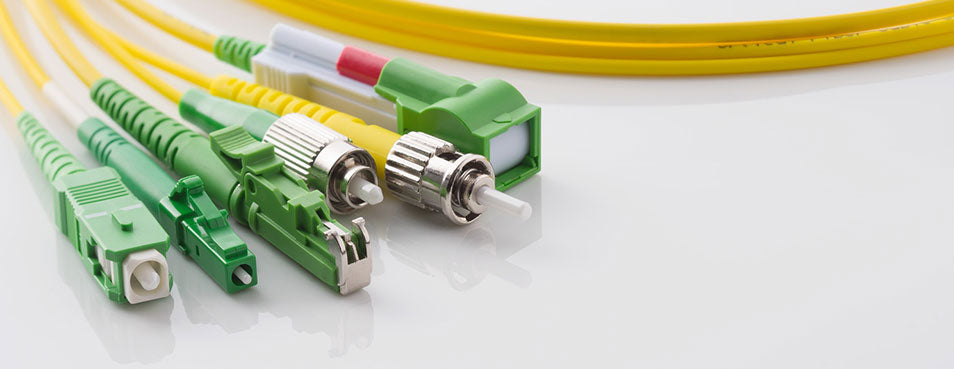
Fiber-Optic Cable Connectors
Updated on 03/18/2021
Fiber-Optic Cable Connectors – Making the Connection
Fiber-optic cable connectors come in different styles to optimize the functionality of fiber cable and simplify application. While there are many types of connectors, their purpose remains relatively the same in comparison to one another. The main function being to link fiber-optic cables and creating a connect and disconnect capability in the process.
What are the main types of fiber-optic connectors?
There are over 100 different types of connectors; the five most widely implemented types that will serve as the basis of this post are LC, SC, ST, FC, and MPO/MTP connectors.
The LC connector, also known as the "lucent connector" or "little connector," is suitable for single mode and multimode fiber cable applications. A notable aspect of the LC fiber connector is the “locking-tab,” securing a precise connection and ensuring proper alignment. This connector gets the moniker "little connector" because it has a ferrule of 1.25-millimeters, which also makes this connector great for high-density uses. This connector is the most commonly used connector type on the market today. Below is an image of the LC connector as well as some links to some of our best selling fiber patch cables and pigtails.
Fiber Optic Patch Cables |
Fiber Pigtails |
|---|---|

The SC fiber connector, or the "square connector," has an identifiable square shape built for either single mode or multimode fiber. This connector is equipped with a 2.5-millimeter ferrule and, like the LC connector, is also commonly used for high-density applications. This is the second most commonly used fiber connector on the market. Below is an image of the SC connector as well as some links to some of our best selling fiber patch cables and pigtails.
Fiber Optic Patch Cables |
Fiber Pigtails |
|---|---|

The ST connector, or "straight tip" connector, has a 2.5-millimeter ferrule, similar to the SC connector. This fiber connector works for both long and short distance applications. This connector is one of the older fiber types and is rarely used, but can still be found in many older fiber networks. Below is an image of the ST connector as well as some links to some of our best selling fiber patch cables and pigtails.
Fiber Optic Patch Cables |
Fiber Pigtails |
|---|---|
|
|

The FC connector, or "ferrule connecter," is the oldest of the fiber connector types. FC fiber connectors are used for single mode fiber, though an alignment key is necessary upon installation in order to ensure the connector is inserted properly. This additional requirement makes the installation process more complex compared to the previously mentioned connectors. Because of this, the FC connector type is largely obsolete. Below is an image of the FC connector.

The MPO/MTP connector is built to hold multiple fibers, either single mode or multimode. The rectangular ferrule has the capacity to hold 12 to 24 fibers. The MPO/MTP connector is more complex than the other connectors because there is a “key-up, key-down” male and female adapter configuration required to establish the connection. Below is an image of the MPO/MTP cable options. Click on the image to be taken to the MPO/MTP Cables page.
There are numerous specifications that differentiate each connector from the other. Depending on the particular details and requirements of a project, the best connector to choose will be subjective. Although, there are many options available so you are guaranteed to find one that meets your needs.
What is the difference between simplex and duplex?
Simplex and duplex connections refer to the ways in which the transmission travels in a cable. Simplex transmission signals are only able to travel in one direction meaning there is no way for a simplex connection to receive a signal through the same means in which the signal was sent. Duplex transmission signals, on the other hand, are engineered to send and receive signals through dual fibers.
When employing simplex and duplex fiber cables, it is important to note that each type requires specific connectors to function properly.
Connector Polish Types
Polish type pertains to the “back reflection” of a signal transmission. When light travels down a fiber it should go straight through to the next one, but sometimes it reflects and bounces backwards and that is back reflection. This back reflection can shorten the life of a transceiver and cause down time, something that you want to avoid. The way the polishing type is cut has an impact on the back reflection and the light source traveling through the fiber.
With that in mind…
Angled Physical Contact (APC) and Ultra Physical Contact (UPC) polish types are only available in single mode 9/125 OS2 fiber. As insinuated in the name of each product, the APC connector is polished at an 8-degree angle, while the UPC has an extended face. The APC polish type will have a <-65db back reflection and the UPC will have a <-55db back reflection.
Flat PC and PC polish types are manufactured for multimode fiber. The Flat PC polish type has “zero domed-shaped geometry,” which differs from the PC polish type that does have a dome shape in order to maximize the transmission signal. The Flat PC has <-30db back reflection and the PC polish type has <-35db back reflection.
As a Final Point
Fiber-optic cable connectors come in numerous variations with specially designed components manufactured to adhere to either single mode or multimode fiber. Knowing the different types of connectors is crucial in establishing a fiber-optic network that will remain optimal and last for years to come.
Having noted the specifics of the main types of connectors, simplex and duplex connections, and polishing types, it is safe to state that there is much to consider throughout the installation process. Nonetheless, we, here at Fiber Savvy, are delighted to help as well as further provide all of the information and supplies needed to establish a cost-effective fiber-optic networking system.

